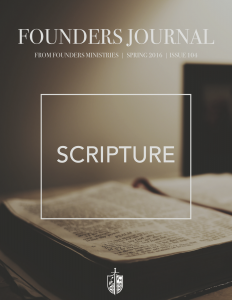Prelude
There is a popular cliché bandied about in popular evangelicalism today concerning Biblical interpretation that screams! “When the plain sense of Scripture makes common sense, seek no other sense; therefore, take every word at its primary, ordinary, usual, literal meaning unless the facts of the immediate context … indicate clearly otherwise.”1 This, according to David L. Cooper is the “The Golden Rule of Interpretation.”2 But what does one do when the passage is not clear, plain, or even obscure? This short inquiry will consider how the historic Second London Confession has dealt with the problem. The paper will examine: (1) What the confession states concerning plain and not so plain passages of Scripture; (2) An explanation of what the Confession says about the clarity or perspicuity of the Scripture; (3) An explanation of what the confession says concerning the “analogy of faith;” (4) A case study from the confession’s stated example passages.
The Words
Paragraphs 7 and 9 of Chapter 1, “Of the Holy Scriptures,” state:
All things in Scripture are not alike plain in themselves, nor alike clear unto all;3 yet those things which are necessary to be known, believed and observed for salvation, are so clearly propounded and opened in some place of Scripture or other, that not only the learned, but the unlearned, in a due use of ordinary means, may attain to a sufficient understanding of them.4
Paragraph 9 continues:
The infallible rule of interpretation of Scripture is the Scripture itself; and therefore when there is a question about the true and full sense of any Scripture (which is not manifold, but one), it must be searched by other places that speak more clearly.5
These words precisely duplicate those of the WCF in these paragraphs. Both groups were concerned to declare not only the Reformation standard of Sola Scriptura but the revolutionary principle of distribution of it to the laity.
Concerning the Clarity or Perspicuity of the Scripture
Princeton Divine Charles Hodge speaks concerning the clarity of Scripture: “The Bible is a plain book. It is intelligible by the people. And they have the right, and are bound to read and interpret [it] for themselves; so that their faith may rest on the testimony of the Scriptures, and not on that of the Church.”6 Here he stressed the great Reformation chasm. Whereas the communicants of the Roman Church must look to the priest to interpret the Bible for them in light of their Tradition; the Reformers believed the Scripture was plain enough to be “intelligible by the people.”7 Hodge’s sentiments align with the Baptist Confession; “not only the learned, but the unlearned, in a due use of ordinary means, may attain to a sufficient understanding” of God’s word.”8
Later Hodge discussed the “Perspicuity of the Scriptures” and “The Right of Private Judgment,”9 He summarized; “The People [are] commanded to search the Scriptures.”10 “The Scriptures are not only addressed to the people, but the people were called upon to study them, and to teach them unto their children,”11 he asserts. For him, there is both a personal and corporate incumbency for all to study the Word of God. If one were to inquire: “Why study the Scripture?” or “Does it matter if they are plain or easily understood?” Hodge’s retort would be: “[I]t is maintained that in [the Scriptures are] all things necessary to salvation; they are sufficiently plain to be understood even by the unlearned.”12
Let us consider two contemporary theologians concerning Scriptural perspicuity, Gerald Bray and Wayne Grudem. Bray notes that the perspicuity, or clarity, of Scripture means that the Bible is “read[ily] intelligible to anyone with the normal reading ability of an educated adult.”13 He observes how “Jesus himself … reproached the scribes and Pharisees for not understanding the plain meaning of the text.”14 And these were the learned religious leaders of the day. Jesus’ hermeneutic “was based on the principle that … [the Scripture’s] basic teachings were clear”15 even for the ordinary reader. Further, “those parts of it which were harder to understand were to be interpreted in the light of the clearer passages.”16
Bray reminds us, the Reformation “scholars … reasserted the claim that Scripture was perspicuous, or self-interpreting.”17 They acknowledged, however “that some parts were harder to understand, and they believed that a Christ centered approach to resolving such difficulties was essential.”18 Bray recounts; “The witness of the Church throughout the ages is that ordinary people, who approach … [the Scripture] in faith and humility, will be able to understand what the Bible is getting at, even if they meet with particular points of difficulty here and there.”19
Grudem has a lengthy discussion on perspicuity, though he prefers (for the sake of clarity!) the term “clarity.”20 He grants, “Anyone who has begun to read the Bible seriously will realize that some parts can be understood very easily while other parts seem puzzling.”21 Conversely he observes, “But it would be a mistake to think that most of Scripture or Scripture in general is difficult to understand.”22 For, both of the testaments “frequently affirm that Scripture is written in such a way that its teachings are able to be understood by ordinary believers.”23 Consider Israel’s Shema:24
Hear, O Israel: The LORD our God is one LORD: And thou shalt love the LORD thy God with all thine heart, and with all thy soul, and with all they might. And these words, which I command thee this day, shall be in thine heart: And thou shalt teach them diligently unto thy children….25
The rank-and-file Israeli was to know the Law of the LORD—and was to teach the Law of the LORD to his children. From its earliest inception there has been an explicit command and implication that the Scriptures were clear and could be understood by all, even children. Grudem summarized the issue by stating, “We can affirm that the Bible is written in such a way that all things necessary for our salvation and for our Christian life and growth are very clearly declared in Scripture. . . . [and] that its teachings are able to be understood by all who will read it seeking God’s help and being willing to follow it.”26
Grudem issues one caveat: “Once we have stated this, however, we must also recognize that many people, even God’s people, do in fact misunderstand Scripture.”27 Let us take up his caution.
Concerning the Analogy of Faith and the Scripture
According to Thomas A. Howe, “There is a principle of biblical interpretation called the analogy of faith … popularly understood to mean ‘Scripture interprets Scripture,’ or ‘Scripture interprets itself.’”28 For, “the scope and significance of one passage is to be brought out by relating it to others.”29 This basic idea “The Reformers termed … the analogy of Scripture.”30
At first blush however, this idea can be a bit confusing for the novice. Howe clarifies: “The analogy of faith is not the principle that Scripture interprets Scripture”31 necessarily. But “that all Scripture is in agreement and will not contradict itself.”32 The concept is “based on the principle that its basic teachings . . . [are] clear, and that those parts of it which … [are] harder to understand … [can be] interpreted in the light of the clearer passages.”33 The principle “assumes the unity and harmony of teaching throughout the Bible.”34 Said distinctly, “[when] the multiple passages say something on a topic (either explicitly or implicitly), then what those passages say about that topic will be consistent and will not be contradictory.”35
In sum:
The “analogy of faith” is a reformed hermeneutical principle which states that, since all scriptures are harmoniously united with no essential contradictions, therefore, every proposed interpretation of any passage must be compared with what the other parts of the Bible teach. In other words, the “faith” or body of doctrine, which the scriptures as a whole proclaim will not be contradicted in any way by any passage. Therefore, if two or three different interpretations of a verse are equally possible, an interpretation that contradicts the clear teaching of any other scriptures must be ruled out from the beginning.36
J.I. Packer would add wise words concerning some of the complexities that attend unity and perspicuity:
The scientific study of Scripture is [a] complicated and exacting task. The biblical languages have their own distinctive idioms and thought-forms. Each writer has his own habits of mind, vocabulary, outlook and interests. Each book has its own character, and is written according to stylistic conventions which it is not always easy to see. Each book has its own historical and theological background, and must be interpreted against that background. 37
Biblical interpretation can seem like the proverbial “Gordian Knot.” All attendant language idioms, contexts, personalities, cultures, et al. cited by Packer must be considered in turn. One is obligated to tackle these before a final judgment on a particular passage can be made.38 But the overall unity and perspicuity of the Scripture can be known. Generally the larger context of Scripture concerns; Creation, Fall, Redemption, and Recreation / Culmination.39 From Genesis to Revelation, when one comprehends the overall plan or drama of redemption, the component parts will more easily come into an understandable perspective.
A paradigm from the Confession considered
In Acts 15, Doctor Luke chronicles The Jerusalem Church’s business meeting minutes. The issue at hand—what was to be done with Gentile believers concerning the Law of Moses? This caused the Jewish Christians no small consternation. James recounted Simeon’s40 testimony how God had moved among the Gentiles to take a people for his own name’s sake.41 He then asserts, “And with this the words of the prophets agree, just as it is written.”42
After this I will return
And I will rebuild the tent of David that
has fallen;
I will rebuild its ruins,
and I will restore it.43
It is interesting; the apostles “did not feel it an irksome thing, or consider it out of keeping with their dignity, to profess themselves students of Scripture.”44 And when James spoke of the “prophets,” he quoted but one. The inference is that the “prophets” speak with one voice.45
James applies his selected prophecy to the Church’s present conundrum—how do we deal with these Gentile believers? How do they fit the Mosaic schemata? (It is noteworthy that; an abstract Biblical doctrine, in this case a seemingly obscure Old Testament prophecy, is employed to make a practical application in a concrete Church situation). The Gentiles would be “grafted in”46 and be considered on an equal footing with the Jews as “the people of God.” James understood this as the rebuilding of “the tent of David.” God seems to be doing a new thing—but it was no new thing at all—just the fulfillment of prophecy!
Rather, he was opening up the Scriptures for their religious, cultural, and ethnic Jewish understanding; they are not Jews who are of the physical seed of Abraham only. Amos’s metaphor, the tent of David which has fallen, is now being repaired, rebuilt, and renewed. This renewal is the bringing in of the Gentiles. No doubt there are some reverberations and remembrances of 2 Samuel 7. Any knowledgeable Jew would immediately recall the covenant the LORD made with David. This was a hard concept for them to grasp let alone accept: How could these Gentiles have a full and equal place into the Commonwealth of Israel? But they accept it—for it was of God.
Paragraph 9’s assertion that, “when there is a question about the true and full sense of any Scripture (which is not manifold, but one), it must be searched by other places that speak more clearly;” is seen as Amos’s passage is examined in light of the Jerusalem Council’s concerns for the Gentiles.
G. Campbell Morgan well captures the sense of the Scripture:
[James] … quoted the great word from the prophecy Amos, in which it is predicted that through the triumph and restoration of Israel the Gentiles also should receive blessing—a prophecy not perfectly fulfilled even until this hour; to be fulfilled undoubtedly in the economy of God; a prophecy fulfilled in principle on the day of Pentecost with that little Hebrew community became the true Israel of God; and immediately following, when the prophetic promise was fulfilled in the experience of the Gentiles.47
As we close; it must be reiterated to redundancy—the Scriptures can be known! When a text is obscure, a meaning must be sought elsewhere from a more simple text that sheds light on the vague. But if the one, true, and full sense of any Scripture48 cannot be understood—then more work must be done in mining the text accompanied by prayer. The examiner may even require deep personal scrutiny. For, “God expect[s] all his people … [to] know and be able to talk about his Word, with proper application to ordinary situations in life.”49
1 David L. Cooper, “Rule 3; The Golden Rule of Interpretation,” The Science of Interpreting Scripture, Accessed 27 June 2016 from http://www.biblicalresearch.info/page47.html
2 Ibid.
3 Here the Confession notes 2 Peter 3:16.
4 Confession, 4.
5 Confession, 5.
6 Charles Hodge, Systematic Theology, Vol. I, Introduction, Part I Theology (Grand Rapids: Eerdmans, reprint 1982), 183 (page citations are to the reprint edition).
7 Hodge, 183.
8 See Chapter 1 “Of the Holy Scriptures” [viii] Paragraph 7, page 2 above.
9 Hodge, 183.
10 Hodge, 185.
11 Hodge, 185.
12 Hodge, 184.
13 Ibid.
14 Ibid.
15 Ibid.
16 Ibid.
17 Ibid.
18 Ibid.
19 Ibid.
20 Grudem wrote “The old term for the clarity of Scripture was perspicuity, a term that simply means ‘clarity.’ That term itself is not very clear to people today, and I have not used it in this book.” Wayne Grudem, Systematic Theology (Grand Rapids: Zondervan, 1994), 208.
21 Ibid., 105.
22 Grudem, 105.
23 Grudem, 105.
24 To argue from the greater to the lesser: The Shema—or Israel’s Confession of Faith—is at the heart of Hebrew thought. There is a trickle-down effect, if all are supposed to know it and teach it to their children, then it axiomatically follows that the Scripture as a whole must be clear on some level to those in Israel.
25 Excerpted from Deuteronomy 6: 3-9. KJV. Italics added for emphasis.
26 Grudem, 108.
27 Grudem, 108.
28 Thomas A. Howe, “The Analogy of Faith,” Christian Research Journal Volume 29 Number 2 (2006): This article first appeared in the Practical Hermeneutics column of the Christian Research Journal. Retrieved 5 July 2016 from http://www.equip.org/article/the-analogy-of-faith/
29 Packer, “The Interpretation of Scripture.”
30 Bray, “The Clarity of Scripture.”
31 Howe, “The Analogy of Faith.”
32 Howe, “The Analogy of Faith.”
33 Bray, “The Analogy of Faith.”
34 Howe, “The Analogy of Faith.”
35 Howe, “The Analogy of Faith.”
36 Monergism, “What does the term ‘analogy of faith’ mean?” Retrieved 5 July 2016 from https://www.monergism.com/thethreshold/articles/onsite/qna/analogyfaith.html
37 J.I. Packer, Bible Research, “The Interpretation of Scripture;” http://www.bible-researcher.com/packer1.htmloriginally cited in Fundamentalism and the Word of God (Inter-Varsity Press, 1958), 101-114. The present citation retrieved 6 July 2016 from http://www.bible-researcher.com/packer1.html
38 It is noteworthy that Dr. Roy O. Beaman, Mid America Baptist Theological Seminary professor and linguistic scholar of some note, had many issues that he considered “back burner” issues. He had been considering and turning these over and over in his contemplations for many years and was not fully satisfied to have the definitive answer. These are remembrances of Beaman’s theological lectures in which I was blest to sit from c. 1982-1983. On the other hand it has been attributed to Dr. Karl Barth, one of the greatest theological minds of the 20th Century: “Jesus loves me this I know, for the Bible tells me so.” Point being: The Scriptures can be known and understood by all who will take up the task. But there remains a simply profound lifelong study for those who would have Christ and His Gospel.
39 Note: For more on this formulaic motif; Creation, Fall, Redemption, Re-creation / Culmination; please consult: Albert Bayless’s From the Creation to the Cross, Paul R. House & Eric Mitchell’s Old Testament Survey, and Gordon D. Fee & Douglas Stewart’s How to Read the Bible for All Its Worth.
40 Note: B.H. Carroll comments; “James got up and said what Simeon said (he calls him Simeon, which is the Aramaic name for Simon [or Peter].” For further discussion see: B.H. Carroll, An Interpretation of the English Bible, vol. Acts (Nashville: Sunday School Board of the Southern Baptist Convention, 1916), 302.
41 Duke paraphrase, Acts 15: 13-14.
42 Acts 15:15, English Standard Version. (ESV).
43 Acts 15:16, (ESV). This is a quote from the Old Testament, Amos 9: 11ff.
44 David W. Torrance & Thomas F. Torrance, eds., John Calvin, Calvin’s New Testament Commentary, vol. Acts of the Apostles Vol. II, trans. John W. Fraser (Grand Rapids: WB Eerdmans, 1973), 46.
45 Matthew Poole, Matthew Poole’s Commentary on the Holy Bible, vol. III Matthew-Revelation (MacLean: MacDonald Publishing), 434.
46 See: St. Paul’s discussion in Romans 11 on the “grafting of the Gentiles.”
47 G. Campbell Morgan, The Acts of the Apostles (London: Pickering & Inglis, 1924), 283.
48 The Baptist Confession of Faith & The Baptist Catechism, (Vestavia Hills, AL and Carlisle, PA; Solid Ground Christian Books and Reformed Baptist Publications, 2010).
49 Grudem, Systematic Theology, 106.


















